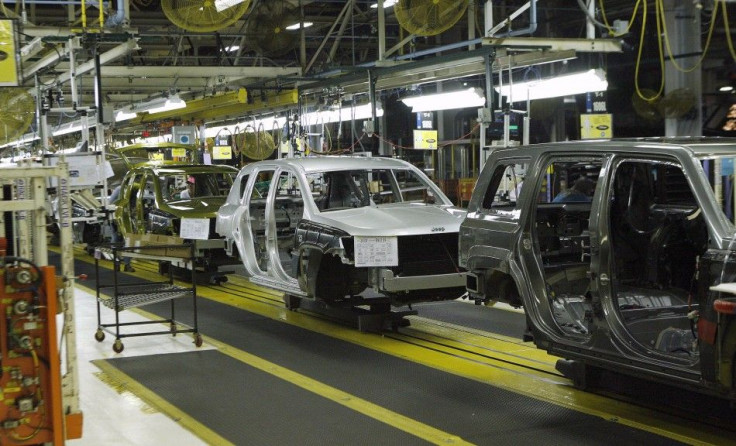Signs Of Worsening Global Slowdown: Economic Data Wrap

Weak economic data from Europe, China, Japan and the U.S. reinforced fears of a deeper global downturn.
Euro zone private sector economic activity contracted at the fastest rate since June 2009, defying hopes that the aggressive new policy from the European Central Bank would help reignite growth in the single currency bloc.
Europe's troubles continued to hit exporters around the world. Thursday's purchasing managers indexes, which survey thousands of companies worldwide every month, showed Chinese factory activity shrank for an 11th month in September, while Japan’s exports tumbled for a third month in a row in August. Things aren’t looking any better for the U.S., where factory activities suffered its weakest quarter in three years.
“The overall message is that things haven’t changed much from last month. Our forecast that the euro zone recession will only deepen from here and that growth in China will slow further suggests that the outlook for U.S. manufacturers isn’t very rosy,” Paul Dales, senior U.S. economist at Capital Economics, said in a note.
Here's a snapshot of the health of the global economy:
Euro Zone
Business activity in the euro zone declined at a faster pace in September, data released by Markit Economics showed Thursday, increasing the likelihood that the currency area entered recession in the third quarter.
Markit Economics said its purchasing managers' index, or PMI, for the manufacturing and services sectors fell to 45.9 from 46.3 in August. Below 50 denotes contraction and Markit said the surveys were consistent with a roughly 0.6 percent economic contraction in the third quarter.
The composite PMI indicates that private sector output declined at the fastest pace since June 2009, and for the 12th time in the past 13 months. While the decline in manufacturing eased, it accelerated in the services sector, which is more reliant on domestic demand.
"The fall in the PMI is another reminder that the ECB's new asset purchase programme is not an answer to all of the region's problems," said Ben May, European economist at Capital Economics, in a research note. "The euro zone recession looks set to deepen in the latter part of the year."
While the downturn in Europe's largest economy, Germany, eased by a surprising amount in September, French firms fell deeper into the mire and at a far faster rate than expected.
Business activity in France shrank at its fastest rate since April 2009 as weak domestic demand and a deepening slowdown in southern Europe dragged the bloc’s second-largest economy towards contraction. In Germany, the seasonally adjusted purchasing managers’ index, or PMI, for manufacturing rose to 47.3 in September from 44.7 in August.
China
Chinese industrial activity has remained subdued in September but has shown some signs of stabilizing at a weak level, according to a widely watched survey published Thursday.
The HSBC flash manufacturing PMI, the earliest of the economy’s monthly indicators, inched up to 47.8 in September from the final reading of 47.6 in August.
However, it was still below the 50 mark, pointing to a contraction and reinforcing market expectations that the world’s second-largest economy is on track to slow further in the third quarter from its 7.6 percent growth rate recorded in the second quarter, which was already the slowest pace in three years.
“The recovery of the manufacturing sector is clearly slow and difficult, without any sizable easing from Beijing,” Société Générale's China macro strategist Wei Yao said in a note.
Many observers believe that China’s central bank will not make any major move to loosen monetary policy and Beijing will not deploy large-scale stimulus ahead of China’s leadership handover, which is set to take place in October.
“We are now approaching the one-year anniversary of this index dropping below 50 and a recovery is still not in sight,” said Mark Williams, chief Asia economist at Capital Economics, in a note.
U.S.
U.S. manufacturing closed out its weakest quarter in three years this month.
The flash U.S. Markit manufacturing PMI in September was exactly in line with August’s final reading of 51.5, leaving this survey consistent with annualized gross domestic product growth of between 1.5 percent and 2.0 percent.
The index averaged 51.5 in the third quarter, below the 54.2 registered between April and June, for its worst showing since the third quarter of 2009. At 51.2, the output component was the lowest since September 2009.
“It suggests that industrial activity could soon stagnate,” Paul Dales, senior U.S. economist at Capital Economics, said in a note. “This survey is another sign that subdued demand overseas is holding back the US economy.”
A separate report showed factory activity in the U.S. mid-Atlantic region shrank in September, but at a slower pace.
Despite rising to -1.9 in September, from -7.1 in August, the Philadelphia Federal Reserve Bank’s index still suggests that the manufacturing industry is currently one of the weakest parts of the economy.
This is the third and final manufacturing survey to be released this week – one has risen, one has fallen and one has stayed the same.
Also on Thursday, the Conference Board said its index of leading indicators, designed to forecast future economic activity in the U.S., dipped 0.1 percent in August after rising 0.5 percent in July and dropping 0.5 percent in June.
Japan
Japan recorded another steep fall in exports in August. The figures came one day after the Bank of Japan’s surprising announcement of an expansion in its balance sheet, one month earlier than most economists had expected.
In justifying the timing of the easing, the central bank emphasized that the weakening of the global economy is reducing Japan’s exports. The Bank of Japan downgraded its assessment for September. The government last week likewise cut its economic assessment, for the second straight month.
Thursday’s government data showed that shipments slipped almost 6 percent from a year earlier to ¥5 trillion ($64 billion), the third monthly fall in a row, while imports were 5.4 percent lower at ¥5.8 trilion.
The resulting trade deficit of ¥754.1 billion was among the widest since March 2011, when the Fukushima crisis led to the staggered closure of the country’s nuclear reactors.
“August trade data shows that the hoped-for recovery in external demand has yet to materialize,” HSBC Japan Economists Izumi Devalier said in a note. “While the Bank of Japan sought to offer exporters relief through yesterday's monetary easing announcement, stubborn yen strength and weak overseas demand continue to cloud Japan's economic outlook.”
© Copyright IBTimes 2024. All rights reserved.






















